14 High-Fiber Snacks To Increase Your Intake
Medically reviewed by Aviv Joshua, MS
Boosting fiber intake is key to supporting digestive health and overall well-being. Fiber improves gut motility, nurtures beneficial gut bacteria, and can help lower LDL cholesterol levels, reducing the risk of heart disease. Plus, fiber may help with weight management and lower the risk of type 2 diabetes and colon cancer.
Many plant-based foods like fruits, vegetables, and whole grains are good sources of dietary fiber. However, many Americans fall short of the recommended daily fiber intake. Adding small amounts of fiber to your diet throughout the day can help you meet your fiber goals. Start with these 14 delicious and nutritious high-fiber snacks for inspiration.
Hummus With Raw Veggies
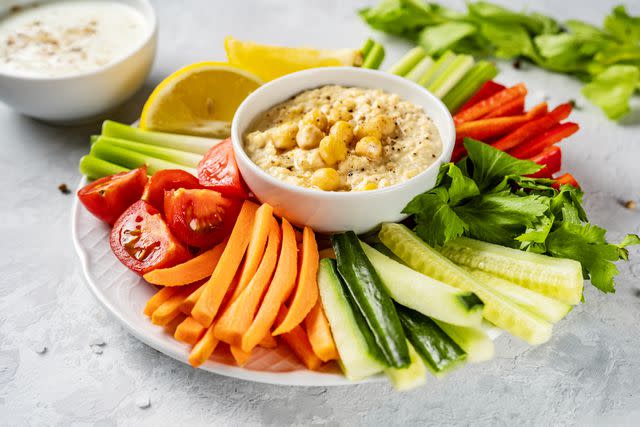
Yummy pic / Getty Images
Hummus, made from chickpeas, tahini paste, olive oil, garlic, lemon juice, and seasonings, offers heart-healthy fats, fiber, and protein. A half-cup serving contains 6.75 grams (g) of fiber.
The smooth texture of hummus makes it a perfect dip or spread for raw veggies like carrots (3.42 g of fiber per cup) and broccoli flowerets (1.63 g of fiber per cup).
Green Smoothie
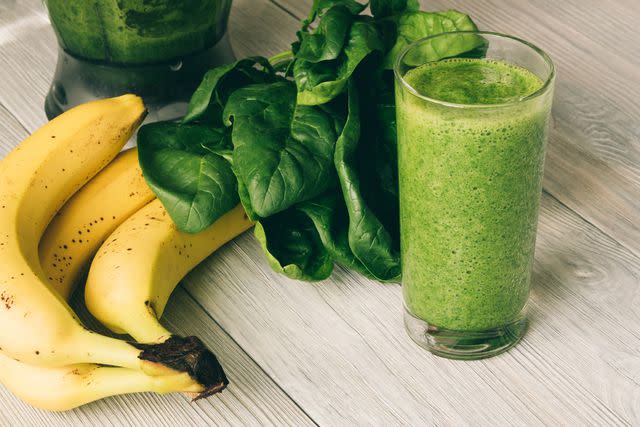
iprogressman / Getty Images
For a revitalizing boost of fiber, whip up a green smoothie. Toss one cup of frozen spinach (4.52 g of fiber) and half a banana (about 1.6 g of fiber) into a blender along with your preferred milk. Blend until smooth.
Spinach and banana are also both packed with potassium, important for heart health. For extra flavor, consider adding a dash of vanilla extract and a sprinkle of cinnamon.
Apple Slices With Almond Butter
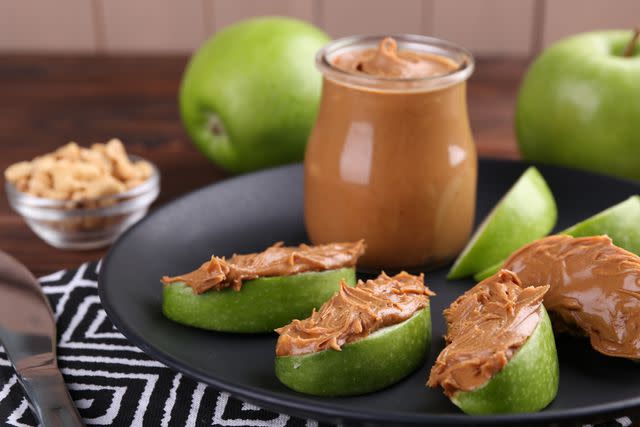
Liudmila Chernetska / Getty Images
Apple slices and almond butter make a nutritious sweet and savory snack duo. A cup of sliced raw golden delicious apple offers 2.62 g of fiber, while two tablespoons of almond butter provides 3.3 g of fiber as well as healthy fats and protein. Plus, apples contain quercetin, a natural plant pigment with antioxidant and anti-inflammatory effects.
Edamame
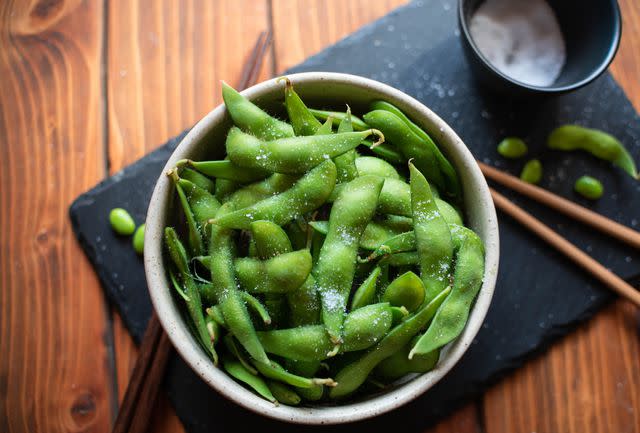
Nevena Zdravic / Getty Images
You can enjoy edamame, or young soybeans, by boiling or steaming the pods until tender. Then, toss them with sea salt or your favorite seasoning, minced garlic, and sesame oil before popping the beans out of their shells and eating them. One cup of edamame prepared from frozen contains 8.06 g of fiber and 18.4 g of protein.
Air-Popped Popcorn
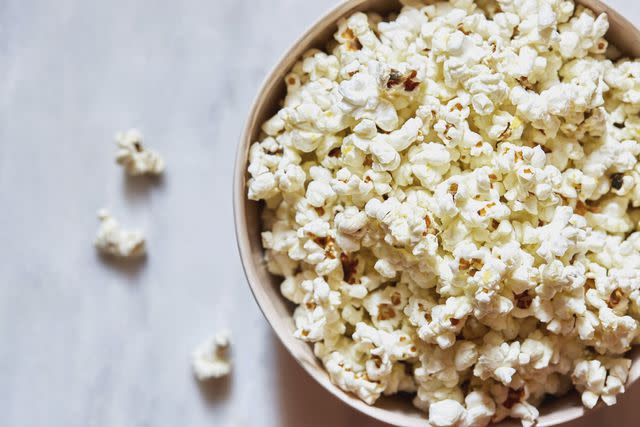
Tetra Images / Getty Images
Plain air-popped popcorn can be a nutritious, low-calorie snack, with three cups containing 3.63 g of fiber and just 91.8 calories. Customize your air-popped popcorn with a sprinkle of sea salt or your choice of dried spices and herbs and a drizzle of heart-healthy olive oil. This can add flavor to your popcorn without taking away from its natural health benefits.
Avocado and Hard-Boiled Egg on Toast
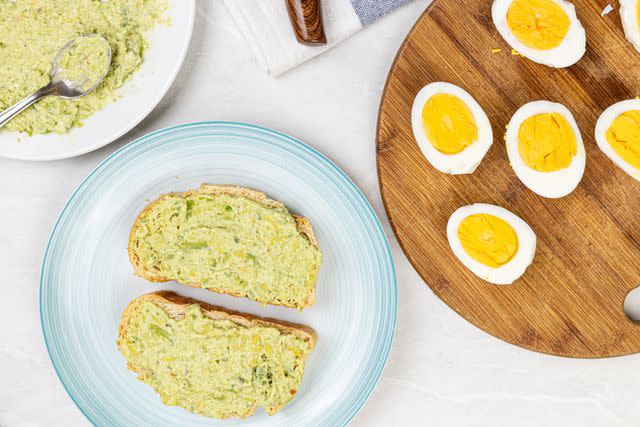
Antic Zlatko / Getty Images
Pairing protein-packed eggs with a healthy fat like avocado makes for a satisfying snack. A 100 g serving of avocado (about half an avocado) provides 6.7 g of fiber, along with vitamins like vitamin C, vitamin E, and folate. One large egg contains about 6 g of protein.
To prepare, simply mash a hard-boiled egg and half a ripe avocado in a bowl until smooth, then season to taste. Spread this mixture onto a slice of toast, opting for whole-grain bread for extra fiber.
Yogurt With Raspberries
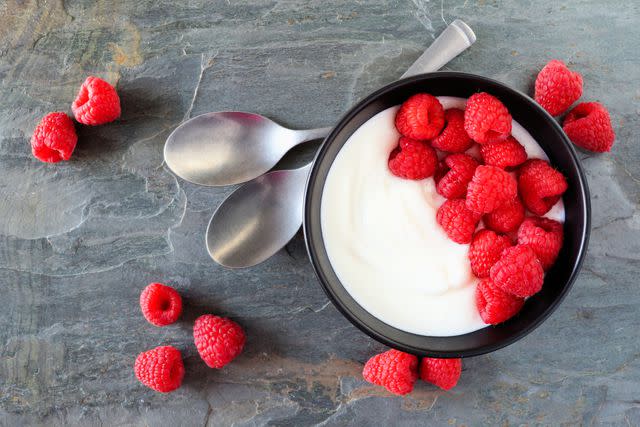
jenifoto / Getty Images
Raspberries are rich in fiber, boasting 8 g in a one-cup serving. They're also high in vitamin C and antioxidants, as well as manganese, a mineral involved in bone health, and immune function.
Yogurt is a great source of gut-friendly probiotics as well as protein, with one cup of plain, whole-milk yogurt containing 8.5 g of protein. Top one cup of plain yogurt with raspberries for a tart and sweet, satisfying snack.
Oatmeal With a Fiber Boost
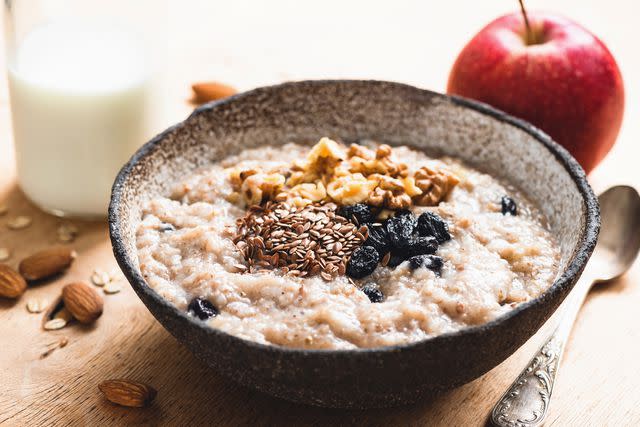
Arx0nt / Getty Images
Oats aren't just a nutritious breakfast; they're also an excellent snack choice. Along with being quick and easy to make, oats are packed with beta-glucan, a type of fiber known for its cholesterol-lowering and antidiabetic properties.
One packet of dried instant oats (28 g) provides 3.01 g of fiber. Boost the fiber content even further by adding two tablespoons of peanut butter (1.6 g of fiber) and a tablespoon of ground flaxseed (1.91 g of fiber).
Chia Seed Pudding
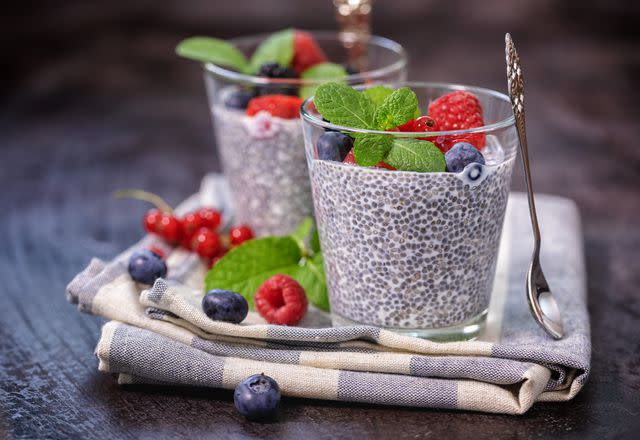
kajakiki / Getty Images
Chia seeds are a nutritional powerhouse, boasting fiber, protein, vitamins, minerals, and antioxidants. Research suggests that incorporating chia seeds into your diet may help lower blood pressure, cholesterol, and blood sugar levels.
Just one ounce (oz) of chia seeds delivers 9.75 g of fiber and 4.68 g of protein. To make chia seed pudding, mix chia seeds with your choice of milk and any desired flavorings. Then refrigerate the mixture until thickened, and enjoy.
Trail Mix With Nuts
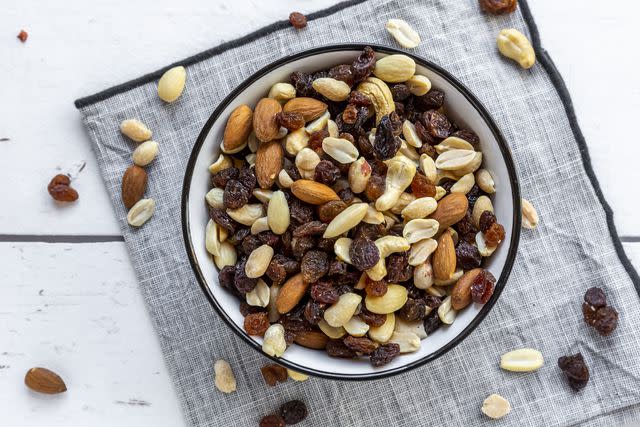
lacaosa / Getty Images
Portable and convenient, trail mix usually comprises a blend of nuts, seeds, and a touch of sweetness from dried fruits or chocolate. A 50 g package of nut-based trail mix offers approximately 4.05 g of fiber. Nutrition content can vary, so compare product labels and opt for a trail mix rich in nuts and seeds for higher fiber and nutritional value.
You can also make trail mix at home by combining your favorite nuts and seeds, such as almonds, pecans, and sunflower seeds, and adding a handful of chocolate chips or raisins.
High-Fiber Cereal
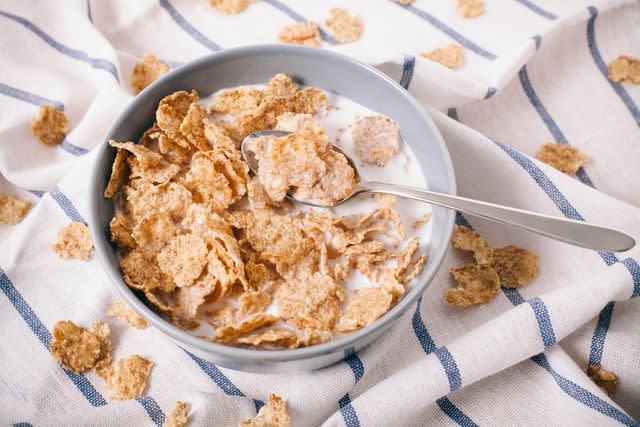
agrobacter / Getty Images
Handy and accessible, dry cereal can be a high-fiber snack, especially if you choose fiber-rich options. Plus, some cereals are fortified with vitamins and minerals such as B vitamins and iron. Look for cereals that list whole grains, oats, or other high-fiber ingredients as the first few items on the ingredient list.
Try choosing a cereal that contains at least 5 g of fiber per serving. For instance, a cup of dry whole wheat cereal offers 7.92 g of fiber. You can enjoy cereal as is, with milk or yogurt, or by adding fruit, nuts, seeds, or spices to enhance its flavor.
Oven-Roasted or Air-Fried Chickpeas
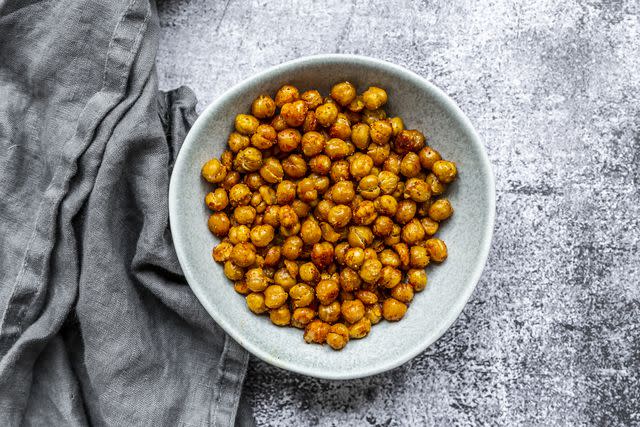
lacaosa / Getty Images
Chickpeas can be oven-roasted or air-fried to achieve a crispy texture, perfect for a crunchy snack craving. Before cooking, make sure the chickpeas are completely dry, and then coat the chickpeas with olive oil and seasoning like garlic powder, paprika, cumin, or chili powder.
One cup of canned drained chickpeas contains 9.58 g of fiber. Chickpeas and other legumes are rich in various nutrients including plant protein, B vitamins, folate, iron, and potassium.
Peanut Butter and Banana Sandwich
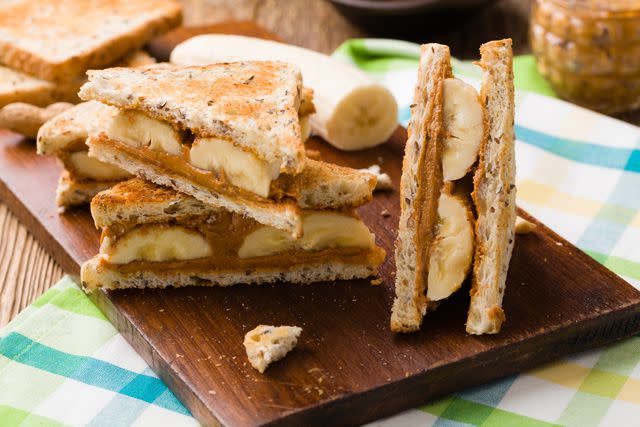
gkrphoto / Getty Images
Boost the fiber content and flavor of a peanut butter sandwich by adding thin banana slices and using high-fiber bread. Bread options vary significantly in their nutritional value. Compare labels and choose a bread that lists whole-grain ingredients at the top of their ingredient list.
A slice (43 grams) of whole wheat bread, for instance, can offer 3.01 g of fiber. Pair it with half a banana (1.6 g of fiber) and two tablespoons of peanut butter (1.6 g of fiber) for a high-fiber snack.
Quinoa and Black Bean Dip
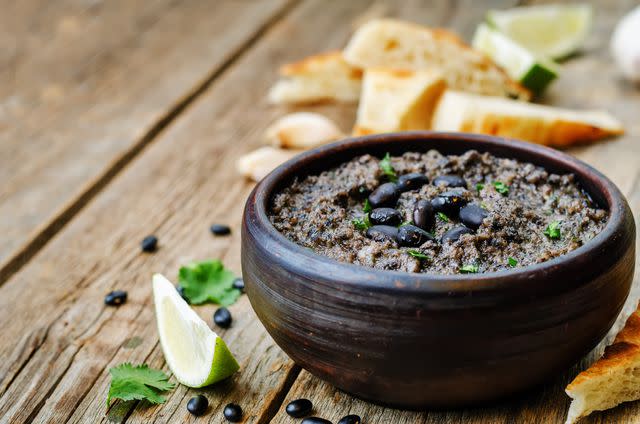
nata_vkusidey / Getty Images
Gluten-free and nutrient-rich, quinoa contains compounds that appear to have antioxidant, antidiabetic, anti-inflammatory, and anticancer properties. One cup of cooked quinoa provides 5.18 g of fiber and 8.14 g of protein.
Legumes like black beans are also a good source of fiber and plant-based protein. A 100 g serving of black beans offers 6.7 g of fiber and 6.9 g of protein.
Blend cooked quinoa with black beans or your preferred beans, lime juice, cilantro, garlic, and spices like cumin and chili powder to make a flavorful and nutritious dip. Serve with whole-grain crackers for dipping or add as a stuffing to lettuce wraps.
How Much Fiber Do You Need Per Day?
The Dietary Reference Intakes (DRIs) tell you how much of each nutrient is needed to keep the body healthy. When it comes to fiber, the DRIs provide specific recommendations tailored to different age groups and genders.
Adult women aged 19 to 50 are advised to aim for 25 g of fiber per day, while men in the same age range should target 38 g. These recommendations shift slightly with age. Women above the age of 50 are advised to consume 21 g, while men over 50 should aim for 30 g daily.
Increase your fiber intake gradually to allow your body to get used to it and to avoid gas, bloating, and cramps. You should also make sure to get plenty of fluids, as water can improve fiber function and proper digestion.
Risks of Eating Too Much Fiber
Consuming excessive fiber without enough fluids may result in bloating, diarrhea, or intestinal blockage. You may need to increase your fluid intake along with your fiber intake to reduce your risk of side effects and prevent dehydration.
For people with certain digestive conditions such as Crohn's disease and intestinal obstruction (blockage), a healthcare provider may need to monitor your fiber intake to avoid additional symptoms. People prone to phytobezoars—dense masses formed from fiber in the digestive system that can cause blockages—should be cautious not to overconsume fiber.
A Quick Review
Incorporating high-fiber snacks into your diet can help you increase your overall fiber intake to maintain proper digestion and promote general health. Plenty of fruits, vegetables, and whole grains provide good sources of fiber. Foods like chickpeas, apples, bananas, avocados, oatmeal, peanut butter, nuts, and seeds are all rich in fiber and can make for delicious snacks.
Remember to drink plenty of fluids when increasing your fiber intake to support healthy digestion and prevent potential discomfort.
For more Health.com news, make sure to sign up for our newsletter!
Read the original article on Health.com.

